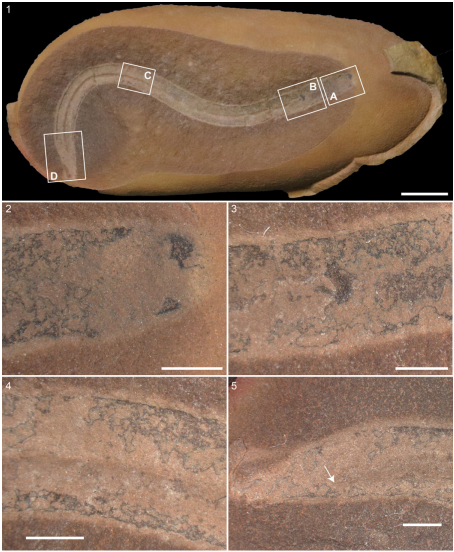Vermiform (Worm-like) fossils assigned to the species Nemavermes mackeei have been described from the 308.6–308.4 million year old Mazon Creek Lagerstӓtte of Illinois, and the 330.3–323.4 million year old Bear Gulch Limestone in Montana. These are between 40 and 140 mm in length, and between 3 and 16 mm in width, and have been interpreted as free-living marine Nematodes.
In a paper published in the Journal of Paleontology on 1 December 2023, Victoria McCoy of the Department of Geosciences at the University of Wisconsin-Milwaukee, and the School of Geography, Geology, and the Environment at the University of Leicester, Jack Wittry of the Field Museum of Natural History, Hamed Sadabadi of the Department of Materials Science and Engineering at the University of Wisconsin-Milwaukee, and Paul Mayer, also of the Field Museum of Natural History, re-examine specimens assigned to Nemavermes mackeei, and conclude that the taxon is not valid, and that the specimens assigned to this species belong to a variety of different Vermiform Animals, including a new species of Cyclostome (the group of Jawless Fish which includes modern Hagfish and Lampreys).
Examination of the holotype of Nemavermes mackeei, FMNH PE 21551, shows that it is a proboscis of the well-known (but hard to interpret) Mazon Creek fossil Tullimonstrum gregarium. In taxonomy, a specimen is deemed to belong to a species if it can be shown to belong to the same species as the holotype. Since the holotype of Nemavermes mackeei, FMNH PE 21551, clearly belongs to the same species as the holotype of Tullimonstrum gregarium, PE 10504, which was named first, then Nemavermes mackeei must be considered to be a junior synonym of Tullimonstrum gregarium, rather than a valid species.
Many specimens assigned to Nemavermes mackeei, however, are clearly not specimens of Tullimonstrum gregarium, but of a vermiform Animal, which McCoy et al. interpret as a new species of Cyclostome, and name Squirmarius testai, where 'Squirmarius' means 'one who squirms' and 'testai' honours fossil hunter Tom Testa, who collected many of the specimens assigned to the new species, and who referred to these fossils as 'squirms'.
Squirmarius testai is a vermiform Animal, frequently showing soft tissue preservation, with a tapering posterior end (tail) and a blunter anterior end (head). None of the specimens preserve any fins, including specimens where the areas of a Cyclostome where fins would be expected are well preserved. The stem Hagfish, Gilpichthys greenei, also from the Mazon Creek Lagerstӓtte, is also interpretted as beign finless, so this is not an implausible state for a Cyclostome from this era. However, in some specimens of the Lamprey, Mayomyzon pieckoensis, and the Hagfish, Myxinikela siroka, fins are not preserved, though other specimens are known to have fins, suggesting that preservation can vary in Mazon Creek Cyclostomes.
Several specimens assigned to Squirmarius testai have dark segmented structures which McCoy et al. interpret as myomeres (blocks of skeletal muscle tissue arranged in sequence). Also present in many is a lighter structure running through the centre of the body, interpreted as a gut, and some unidentified darker regions, which may be internal organs.
Many specimens have eyes preserved as dark brown-black ovals on both the part and counterpart, with some having central infills of kaolinite, which could represent lenses. Under the scanning electron microscope, it is possible to see ovoid microbodies and moulds of microbodies, which are the size and shape of melanosomes. Melanosomes have been documented in a range of fossil lagerstӓtte, including other Chordates at Mazon Creek, and therefore are not implausible structures to find preserved in Squirmarius testai. Importantly, very few groups of Animals have melanostomes within their eyes; outside of the Chordates, these structures are found only in the eyes of Box Jellyfish and some Flatworms, neither of which resemble Squirmarius testai in form, supporting the idea that this Animal is a Chordate.
None of these features is consistent with Squirmarius testai being a Nematode, including its size, which would be remarkably large in a free-living Nematode (some modern parasitic Nematodes get much larger, but free-living forms tend to be microscopic), supporting McCoy et al.'s belief that Squirmarius testai is a Cyclostome, and probably a stem Hagfish.
See also...
Online courses in Palaeontology.
Follow Sciency Thoughts on Facebook.
Follow Sciency Thoughts on Twitter.










